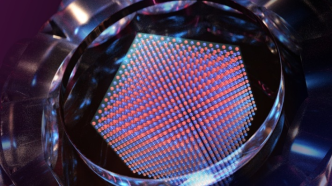
After more than ten years of scientific research, the team led by Academician Pan Jianwei of the University of Science and Technology of China successfully built an ultracold atom quantum simulator to solve the fermion Hubbard model. They verified the antiferromagnetic phase transition in the system for the first time with simulation capabilities that surpass those of classical computers, taking an important first step toward obtaining the low-temperature phase diagram of the model and understanding the mechanism of high-temperature superconductivity. They also opened the door to building a dedicated quantum simulator. The relevant research results were published in the international academic journal Nature on July 10.
The fermion Hubbard model is the simplest model of the laws of electron motion in a lattice, and is considered to be the core physical model that has the potential to explain the mechanism of high-temperature superconductivity, a problem that has plagued the physics community for nearly four decades. Once its physical mechanism is understood, it will be possible to design, produce and apply new high-temperature superconducting materials on a large scale, which will have a revolutionary impact in the fields of power transmission, medicine, supercomputing, etc.
Academician Pan Jianwei introduced that quantum computing provides a new solution to solve some computational problems that classical computers are unable to solve. The international academic community has set three stages for the development of quantum computing:
First, the computing power for specific problems will surpass that of classical supercomputers, achieving "quantum computing superiority". With the realization of Google's "Planeta" and the "Jiuzhang" and "Zu Chongzhi" series quantum computing prototypes of the University of Science and Technology of China, the goal of this stage has been achieved.
The second is to realize a dedicated quantum simulator to solve important scientific problems such as the fermion Hubbard model, which is the current main research goal.
The third is to realize a universal fault-tolerant quantum computer with the assistance of quantum error correction.
Professor Chen Yuao of the University of Science and Technology of China introduced that the antiferromagnetic phase transition refers to the sudden change of the material from a paramagnetic state (the spin directions of the electrons in the material are disordered) to an antiferromagnetic state with orderly arrangement of the electron spins when the system temperature drops below a certain critical temperature. Constructing a quantum simulator to verify the antiferromagnetic phase transition under doping conditions is the first step in realizing a dedicated quantum simulator capable of solving the fermion Hubbard model, and is also an important basis for obtaining the low-temperature phase diagram of the model.
After years of research and development, the research team has achieved a number of technological breakthroughs, creatively combining the box-type optical potential well and the flat-top optical lattice technology to achieve the adiabatic preparation of a spatially uniform fermion Hubbard system. The system contains about 800,000 lattice points, which is about 4 orders of magnitude higher than the dozens of lattice points in the current mainstream experiments. Conclusive evidence of the antiferromagnetic phase transition was directly observed, thus verifying for the first time that the fermion Hubbard model includes the antiferromagnetic phase transition under doping conditions.

Schematic diagram of the Fermion Hubbard quantum simulator. The red and blue balls represent atoms with opposite spins, which are staggered in three-dimensional space to form an antiferromagnetic crystal. The atoms are trapped in a glass vacuum cavity by an optical lattice.
This research achievement has advanced the understanding of the fermion Hubbard model, laid the foundation for further solving the model and obtaining its low-temperature phase diagram, and also demonstrated for the first time the great advantages of quantum simulation in solving important scientific problems that classical computers are unable to solve. The reviewers of Nature magazine spoke highly of this work, saying that it "is expected to become a milestone and major breakthrough in modern science and technology" and "marks an important step forward in this field."